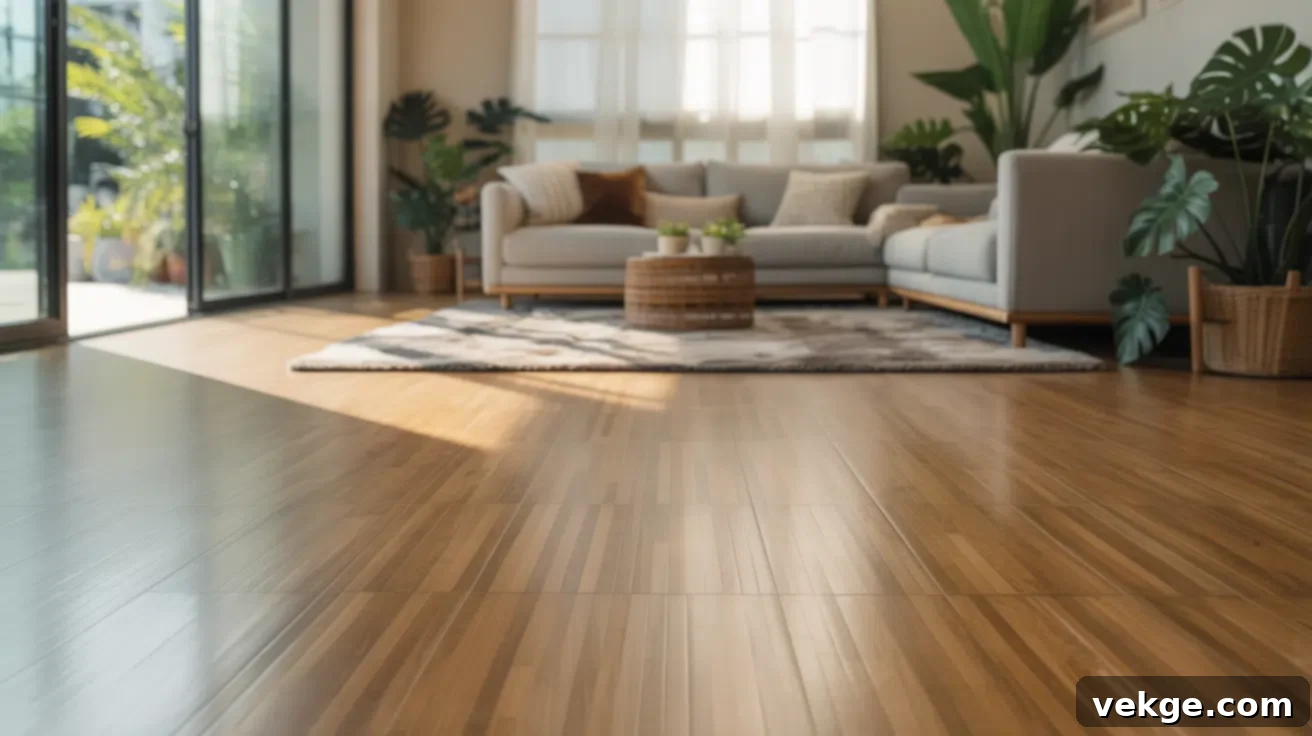Bamboo Flooring: The Ultimate Guide to Pros, Cons, Types, and Care for Your Home
Considering a new floor for your home and curious about bamboo? While it shares a similar aesthetic with traditional hardwood, bamboo flooring offers a unique set of characteristics that make it stand out. Understanding these nuances is key to making an informed decision that aligns with your lifestyle and home environment.
This comprehensive guide will meticulously walk you through the distinct advantages and potential disadvantages of bamboo flooring. We’ll delve into the various types available, explore different finishes, provide essential care tips, and offer detailed comparisons with other popular flooring options. By the end, you’ll have a crystal-clear picture of what to expect from bamboo floors, enabling you to choose with absolute confidence.
If your priority is a cost-effective, durable, and visually appealing flooring solution that brings a modern, clean look to your space, bamboo might be an excellent fit. However, it’s equally important to be aware of scenarios where bamboo may not be the most suitable choice. Let’s explore all facets of bamboo flooring to help you determine if it’s the perfect match for your home’s needs.
Types of Bamboo Flooring: Choosing the Right Construction for Your Space
Bamboo flooring comes in several distinct formats, each boasting a unique structure, varying levels of strength, and specific installation requirements. A thorough understanding of the differences between solid, engineered, and strand woven bamboo is crucial for selecting the ideal flooring based on your room’s conditions, potential moisture exposure, and anticipated foot traffic.
Solid Bamboo Flooring

Solid bamboo planks are crafted from strips of bamboo stalks, which are then compressed together using a combination of heat and specialized adhesives. These planks typically feature either a horizontal or vertical grain pattern, offering a uniform and naturally appealing look. Depending on their thickness, solid bamboo floors can often be refinished once or twice over their lifespan, extending their beauty and durability.
This type of flooring performs optimally in environments with consistent, low humidity and stable temperatures. While generally durable, solid bamboo is more susceptible to expansion or contraction in response to significant climate changes, making careful environmental control essential.
Solid bamboo is traditionally installed using nails or glue, resulting in a more permanent and robust flooring solution compared to floating click-lock systems. It is most frequently chosen for less moisture-prone areas such as bedrooms, living rooms, and hallways where its natural beauty can truly shine.
Engineered Bamboo Flooring
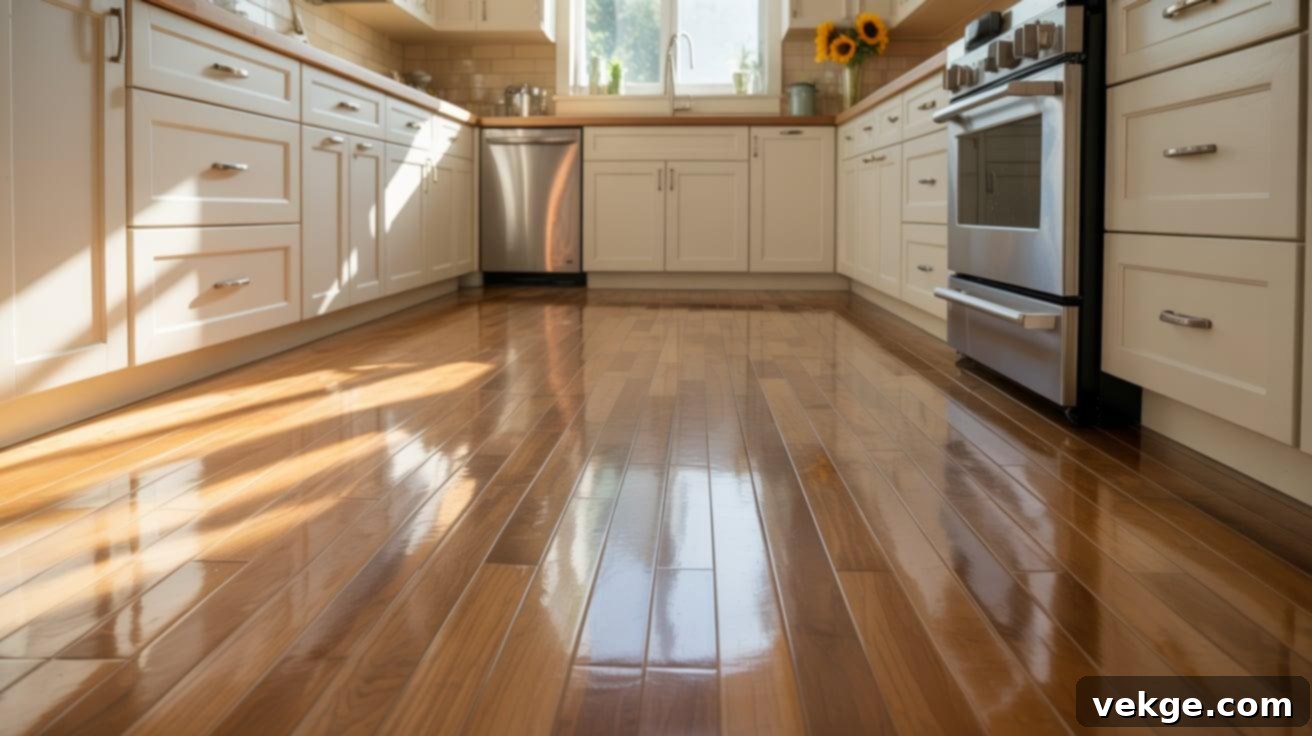
Engineered bamboo represents a sophisticated composite material, designed for enhanced stability. It consists of a thin top layer (veneer) of genuine bamboo, bonded to a highly stable core made from plywood or high-density fiberboard (HDF). This multi-layered construction provides superior resistance to the warping and gapping that can occur with fluctuations in humidity and temperature, making it a more versatile option for areas like kitchens, finished basements, or even light commercial spaces.
Installation is often streamlined and quicker thanks to innovative click-lock edges, which allow the planks to snap together without the need for adhesives or nails in a floating installation. The ability to refinish engineered bamboo depends largely on the thickness of its top bamboo veneer; thinner veneers may not allow for sanding.
Engineered bamboo is an excellent choice for homeowners seeking a harmonious balance between resilience, design flexibility, and improved stability against indoor moisture variations. It provides the aesthetic appeal of bamboo with added performance benefits.
Strand Woven Bamboo Flooring
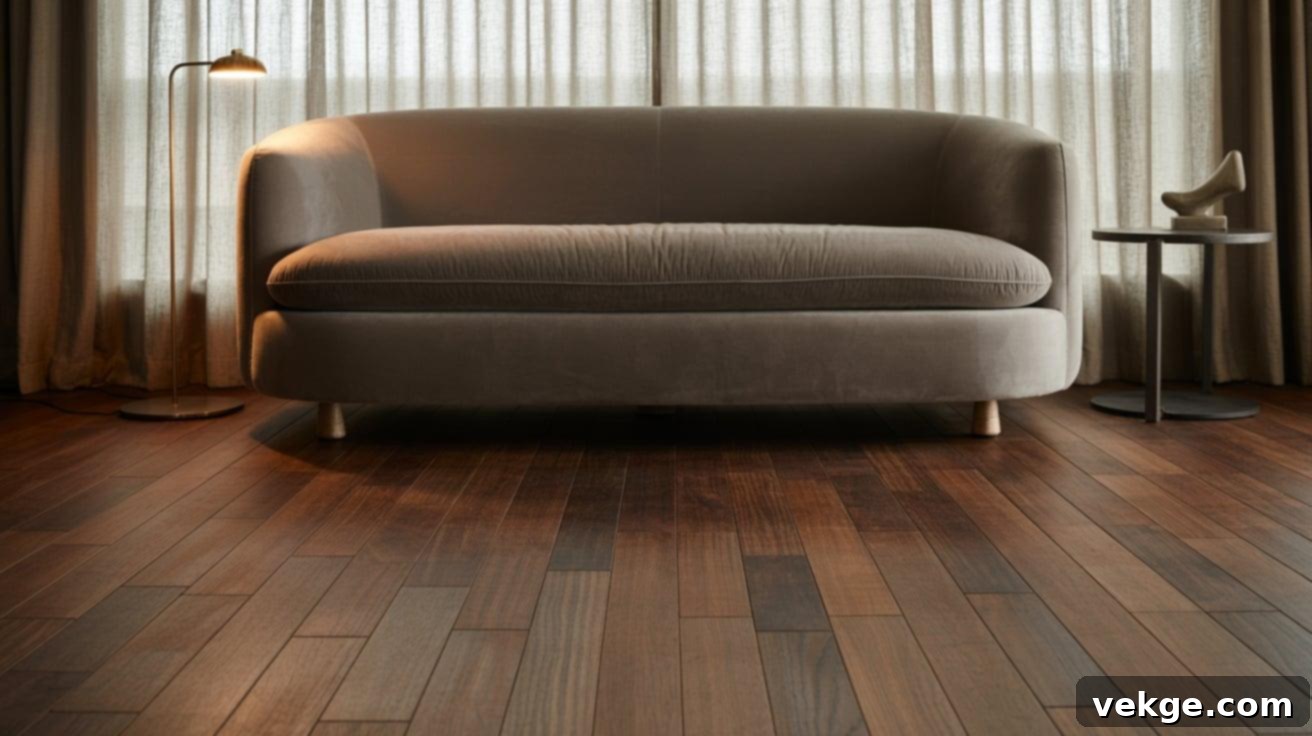
Recognized as the toughest and most resilient among bamboo flooring types, strand woven bamboo is manufactured through an advanced process. Bamboo fibers are shredded and then compressed under extreme pressure, often with the addition of resin binders. This method creates an exceptionally dense, heavy, and incredibly hard plank, boasting superior resistance to dents, scratches, and heavy foot traffic. Its remarkable strength makes it an ideal choice for the most demanding environments, including busy households, high-traffic commercial spaces, and homes with active children or pets.
Strand woven bamboo is available in both solid and engineered constructions, offering flexibility in installation methods, whether glued down, nailed, or floated. Its inherent durability translates into a significantly longer service life compared to traditional bamboo types, making it a wise long-term investment for discerning homeowners.
Bamboo Flooring Finishes: Enhancing Durability and Aesthetics
The surface finish applied to bamboo flooring plays a pivotal role in determining its visual appeal, the level of maintenance required, and its overall durability in everyday use. The type of finish directly influences the floor’s shine, its resistance to scratches, and even aspects of indoor air quality.
Matte Finish

Matte finishes impart a soft, low-sheen surface that excels at camouflaging minor scratches, dust, and footprints, maintaining a consistently clean appearance. This understated elegance makes it a popular choice for casual and contemporary interior designs. Its non-reflective nature also helps to reduce glare from natural light, creating a more comfortable ambiance.
Matte finished bamboo floors perform exceptionally well in high-traffic areas where a pristine, high-gloss look might be challenging to maintain. Due to its ability to hide imperfections, it generally requires less frequent cleaning and touch-ups compared to glossier alternatives. These surfaces are commonly favored in living rooms, bedrooms, and hallways, where a stable, natural appearance is prioritized over a vibrant shine or intense light reflection.
Glossy Finish
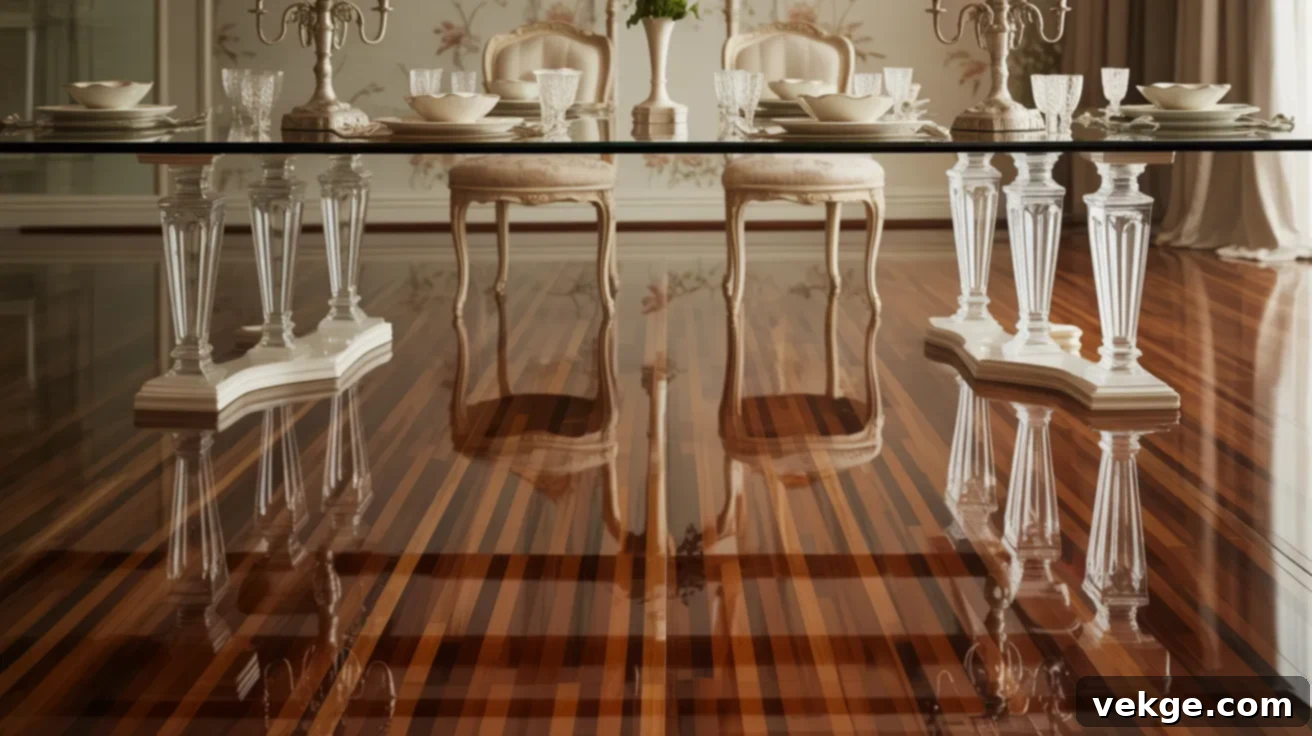
Glossy finishes create a highly reflective and bright surface that dramatically bounces light around a room, vividly highlighting the bamboo’s unique grain patterns and natural color variations. These finishes are typically employed in formal settings or areas specifically designed to draw attention to the flooring as a central design element. The dazzling shine can make a space feel larger and more luxurious.
However, the very characteristic that makes glossy finishes attractive—their shine—also makes scratches, smudges, and dust significantly more visible, demanding diligent cleaning routines. Glossy floors can also feel slick when wet, posing a potential slip hazard. This type of finish is most commonly selected for dining rooms, elegant front entryways, and other spaces where a powerful visual impact and a luxurious aesthetic are primary design considerations.
UV-Cured Finish
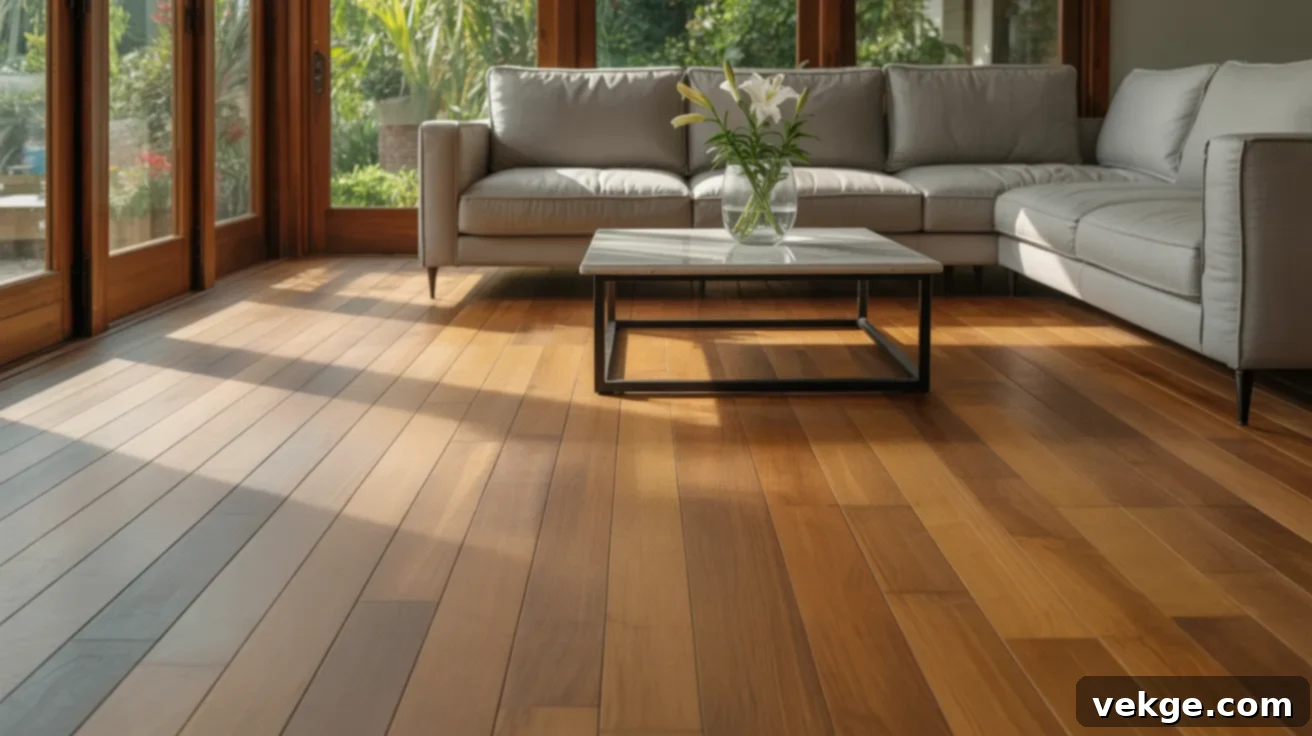
UV-cured finishes represent a cutting-edge approach to floor protection. During the manufacturing process, multiple layers of finish are applied and then instantly hardened using ultraviolet light. This sophisticated process creates an exceptionally hard, durable, and wear-resistant surface that provides superior protection against daily abrasions, scuffs, and general wear and tear. A key benefit is that these floors arrive pre-finished and ready for immediate installation, eliminating the need for on-site drying or curing times, which speeds up renovation projects.
Furthermore, UV-cured finishes often feature low volatile organic compound (VOC) emissions, contributing to better indoor air quality, which is a significant health advantage. These surfaces also exhibit excellent resistance to fading from prolonged sunlight exposure, making them an ideal and long-lasting choice for busy rooms or areas with large windows and abundant natural light.
Oil-Based Finish
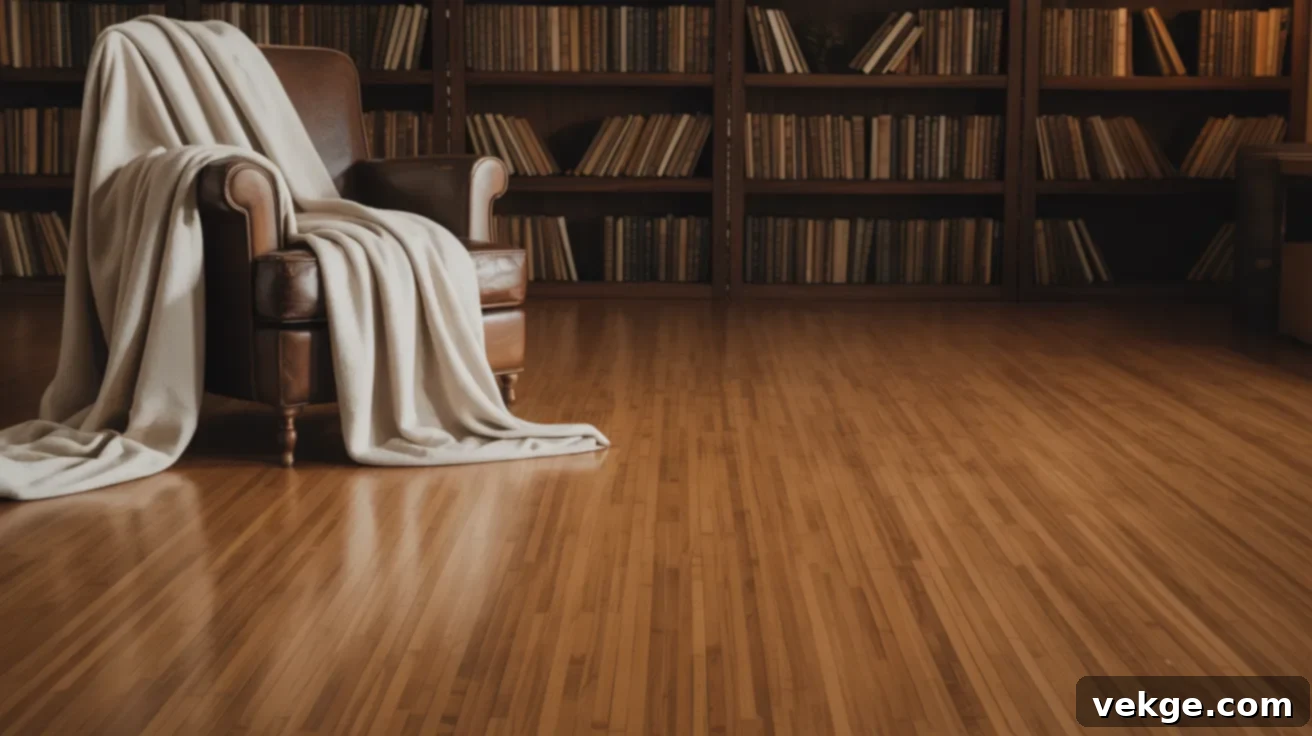
Oil-based finishes penetrate deep into the pores of the bamboo, enriching and deepening the natural tone and character of the wood. Unlike surface coatings, oil finishes remain flexible, allowing the bamboo to breathe and move more naturally. This type of finish offers a very organic and tactile feel, enhancing the inherent beauty of the bamboo. However, to maintain optimal protection and appearance, these finishes require periodic reapplication or re-oiling, typically every few years, depending on traffic.
The drying process for oil-based finishes can be considerably longer than for other types, and they often emit strong odors during application and curing, necessitating good ventilation. While they are relatively easy to repair in small, isolated spots, they may show wear more quickly in areas with high humidity or heavy foot traffic. Oil-based finishes are most often recommended for quieter rooms, such as bedrooms or studies, where floor wear is lighter and easier to manage with a consistent maintenance schedule.
Why Bamboo Flooring is a Good Choice: Exploring Its Key Advantages
Bamboo flooring offers a compelling combination of practical benefits, appealing aesthetics, and cost efficiency, making it a strong contender for both residential and commercial applications. Its unique properties provide reliable performance and a modern design sensibility.
- Eco-Friendly and Sustainable: Bamboo is a rapidly renewable resource, maturing in just 3-5 years, unlike hardwoods that can take decades or centuries. Its fast growth cycle significantly reduces pressure on global forests, positioning it as an environmentally responsible flooring material with a remarkably lower ecological footprint. Opting for bamboo contributes to sustainable forest management and resource conservation.
- Exceptional Durability: Particularly the strand woven varieties, bamboo flooring boasts impressive density and wear resistance. Many strand woven bamboo products achieve Janka hardness ratings comparable to, or even exceeding, those of traditional hardwoods like oak and maple, making them highly resistant to dents, scratches, and daily wear from foot traffic, pets, and furniture.
- Cost-Effective Solution: Generally, bamboo flooring presents a more affordable alternative compared to most solid hardwood options. This makes it an attractive choice for homeowners seeking the luxurious look and feel of wood at a more budget-friendly price point, allowing for significant savings on material costs without compromising on quality or aesthetics.
- Easy and Versatile Installation: Many bamboo planks are designed with convenient click-lock or tongue-and-groove systems, enabling straightforward installation without the need for messy glues or complex nailing. This ease of installation makes bamboo a practical choice for DIY enthusiasts and allows for quicker, more cost-efficient flooring updates. It can often be installed as a floating floor over various subfloors.
- Modern and Clean Aesthetic: Bamboo flooring inherently pairs well with contemporary, minimalist, and clean interior themes. Its smooth, linear grain patterns and often light, neutral tones provide a sophisticated backdrop that beautifully complements a wide range of furniture styles, color palettes, and interior finishes, adding an element of natural elegance to any room.
- Hypoallergenic Properties: The smooth, dense surface of bamboo flooring does not trap dust mites, pet dander, or other allergens as easily as carpets. This makes it an excellent choice for individuals with allergies or asthma, contributing to a healthier indoor environment and easier cleaning for allergen removal.
Possible Drawbacks of Bamboo Flooring: Important Considerations
While bamboo flooring offers many advantages, it also comes with several important limitations that potential buyers should be aware of. These drawbacks are primarily related to its sensitivity to moisture, susceptibility to certain types of damage, limited aesthetic options, and performance under extreme indoor conditions.
- Moisture Sensitivity: Despite some improvements in engineered and strand woven varieties, bamboo flooring remains susceptible to water damage. Prolonged exposure to spills, high humidity, or standing water can lead to swelling, cupping, warping, or even delamination of the planks. This makes it a less ideal choice for consistently wet areas like bathrooms or laundry rooms where moisture contact is frequent.
- Prone to Scratches and Dents: While strand woven bamboo is very hard, all bamboo types can still be marked by sharp objects such as high heels, pet nails, or heavy furniture dragged across the surface. Without adequate protection like felt pads under furniture legs or area rugs in high-traffic zones, the flooring can show wear and tear over time.
- Limited Style and Color Variety: Compared to the vast array of wood species, stains, and finishes available for traditional hardwood, bamboo flooring offers fewer shades and grain styles. While it provides a clean, contemporary look, this can make it more challenging to match with highly specific or traditional design plans that require a broader range of visual textures and colors.
- Quality Inconsistencies: The quality of bamboo flooring can vary significantly between manufacturers. Lower-cost products, often made with inferior adhesives or less stringent compression methods, may be prone to cracking, separating, or emitting strong odors due to higher levels of volatile organic compounds (VOCs). It’s crucial to purchase from reputable brands with established quality control.
- Environmental Sensitivity: Bamboo, being a natural material, can be sensitive to extreme fluctuations in indoor temperature and humidity. Very dry air can cause planks to shrink and develop gaps, while excessive humidity can lead to expansion and cupping. Maintaining consistent indoor climate control, typically between 35-55% humidity, is vital for long-term stability and appearance.
- Potential for Fading: While some finishes offer UV protection, prolonged exposure to direct sunlight can still cause bamboo flooring to lighten or change color over time. This can lead to uneven discoloration if certain areas are consistently exposed to sun while others are not, requiring careful placement of rugs or window treatments.
Bamboo vs. Other Flooring Options: A Comparative Look
When selecting new flooring, bamboo often competes with other popular materials like hardwood, laminate, and vinyl plank. Each option possesses unique strengths and weaknesses that make it suitable for different budgets, durability requirements, and room conditions. Understanding these comparisons will help clarify bamboo’s position in the market.
Bamboo vs Hardwood
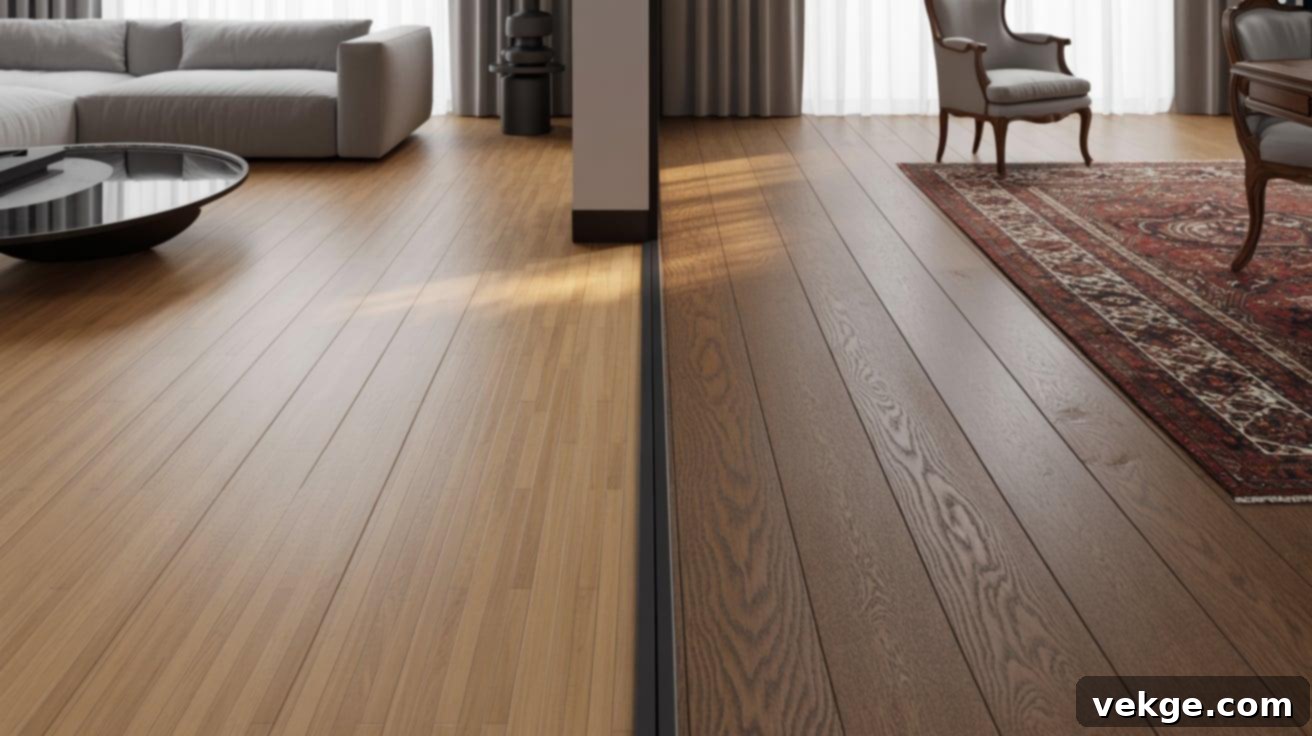
Deciding between bamboo and traditional hardwood flooring involves weighing several factors, including initial cost, specific textural qualities, and long-term maintenance needs. While both offer natural beauty, their distinct characteristics can influence your final decision.
|
Feature |
Bamboo Flooring |
Hardwood Flooring |
|
Cost |
Generally lower than most hardwoods, offering value. |
Often the highest initial cost among common flooring types. |
|
Refinishing |
Limited, depends on product type (solid vs. engineered veneer thickness). |
Can be refinished multiple times over decades, extending lifespan. |
|
Feel |
Firm underfoot, with a slight, subtle bounce. |
Very dense and solid, offering a traditional, robust feel. |
|
Sustainability |
Rapidly growing grass, highly renewable, lower environmental impact. |
Slow-growth trees, requires extensive foresting, less renewable. |
|
Market Appeal |
Modern aesthetic, appeal varies; strong in eco-conscious markets. |
Strong, timeless appeal; consistently adds significant resale value. |
Bamboo vs Laminate
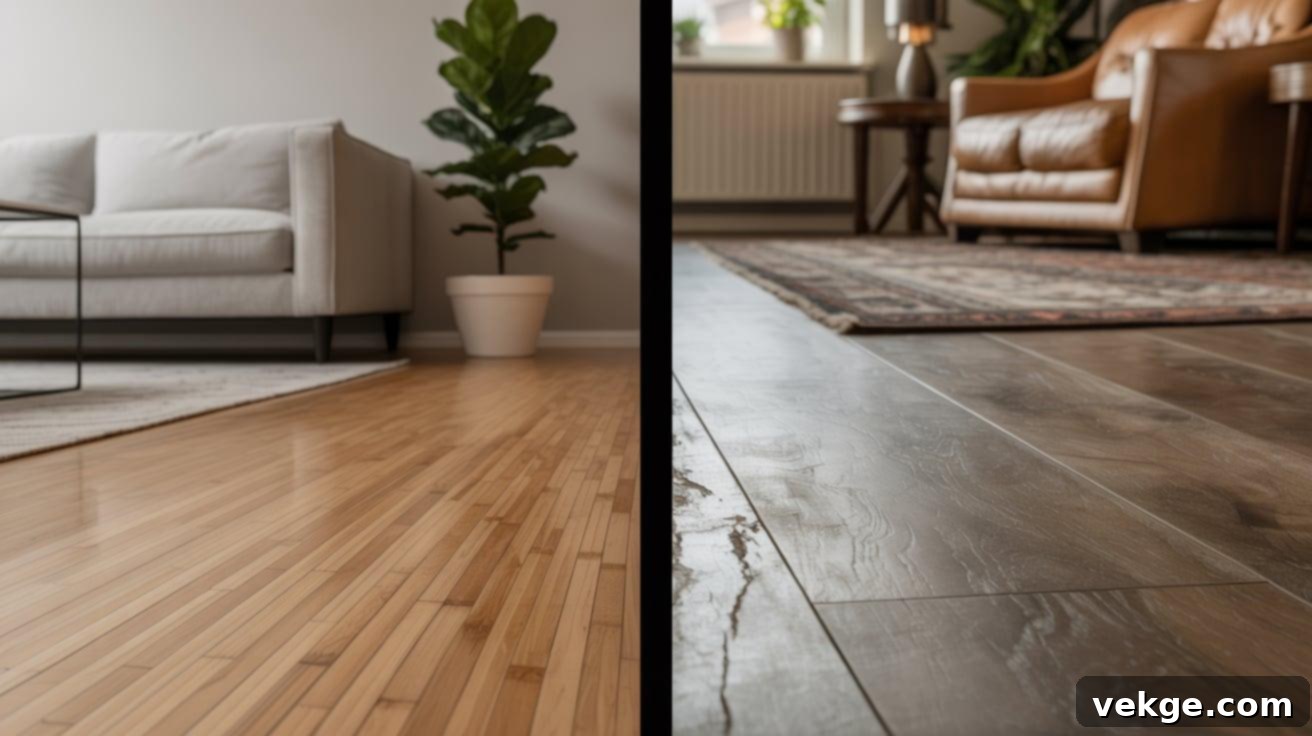
Both bamboo and laminate flooring are popular choices for homes due to their affordability and ease of installation. However, they differ significantly in their composition, resilience to scratches, and moisture handling capabilities. This comparison highlights their core distinctions.
|
Feature |
Bamboo Flooring |
Laminate Flooring |
|
Durability |
Naturally tough, especially strand woven, with a real bamboo top layer. |
Synthetic wear layer; core prone to chips and swelling if exposed to water. |
|
Scratch Resistance |
Moderate, can show marks from pets or furniture; strand woven is best. |
Often higher due to aluminum oxide wear layers; very resilient to surface scratches. |
|
Looks |
Authentic, natural bamboo grain, limited tone and pattern choices. |
Mimics wood or stone; wide range of printed colors and styles. |
|
Resale Value |
Often better than laminate, particularly higher-quality engineered bamboo. |
Lower, perceived as a temporary or budget solution; minimal impact on home value. |
|
Moisture Handling |
Some moisture tolerance, but vulnerable to prolonged exposure and humidity. |
Highly susceptible to swelling and delamination if moisture penetrates edges. |
Bamboo vs Vinyl Plank
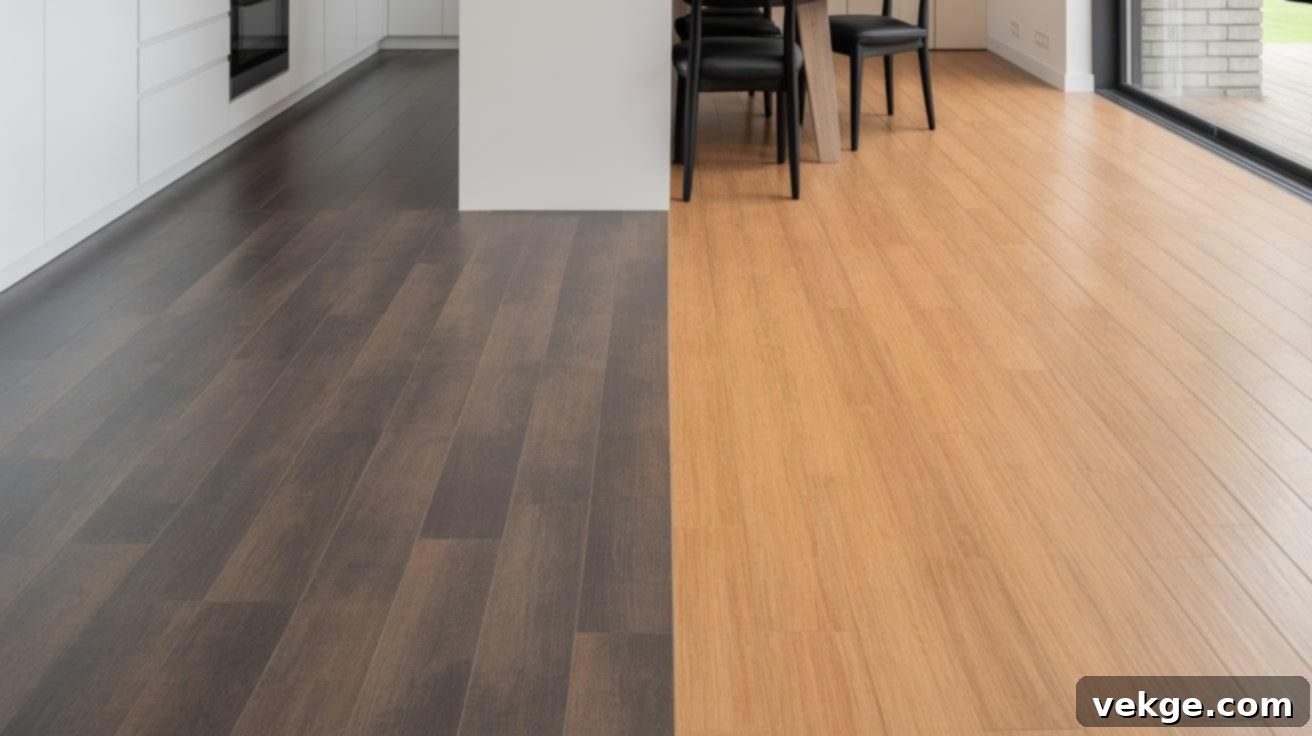
When evaluating bamboo against vinyl plank flooring, the primary differentiators emerge in terms of moisture resistance, underfoot comfort, and the simplicity of installation. Vinyl plank has gained immense popularity for its practical benefits, but bamboo offers a natural alternative.
|
Feature |
Bamboo Flooring |
Vinyl Plank Flooring |
|
Water Resistance |
Handles light moisture and spills if wiped quickly; not fully waterproof. |
Many options are fully waterproof, ideal for bathrooms and wet rooms. |
|
Comfort |
Firm underfoot; can feel hard and echo without proper underlayment. |
Softer, more flexible, and quieter underfoot due to its synthetic composition. |
|
Installation |
Available in click-lock for floating or glue-down options. |
Among the easiest with peel-and-stick, click-lock, or loose lay systems. |
|
Cost |
Mid-range pricing, offering a natural material at a competitive cost. |
Often more budget-friendly, especially for basic or DIY-friendly options. |
|
Long-Term Use |
Very strong and long-lasting if kept dry and maintained well. |
Durable but can show wear over time; softer surface may dent or scratch. |
Strand Woven vs Traditional Bamboo
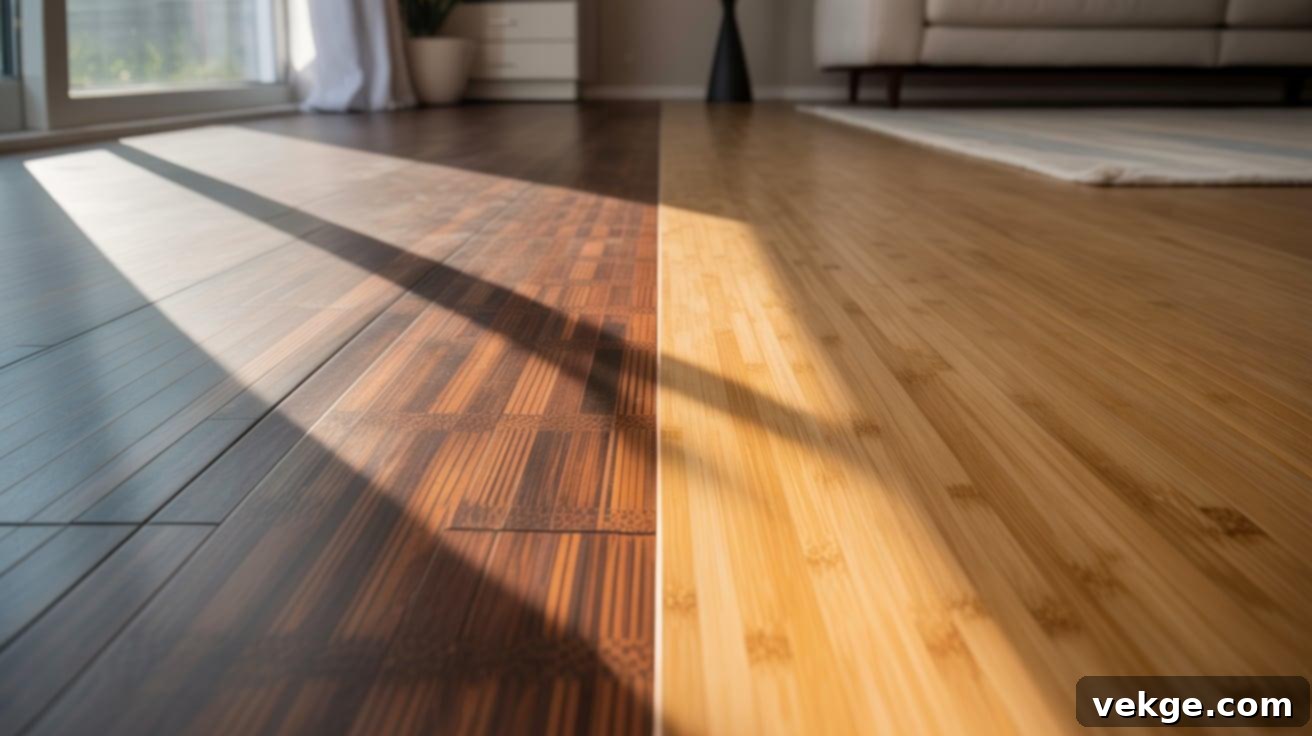
While both flooring types originate from the bamboo plant, their manufacturing processes result in vastly different structural integrity and visual characteristics. This table outlines the major performance and aesthetic distinctions between strand woven and traditional bamboo flooring.
|
Feature |
Strand Woven Bamboo |
Traditional Bamboo (Horizontal/Vertical) |
|
Strength |
Extremely high (Janka rating often 3000+); superior dent resistance. |
Lower (Janka rating around 1300-1500); less durable under pressure. |
|
Grain Appearance |
More varied, textured, and less uniform; resembles exotic hardwood. |
Smooth, even, distinctive linear or nodal grain; classic bamboo look. |
|
Cost |
Slightly higher due to complex manufacturing process and enhanced durability. |
Lower upfront cost, making it a more accessible bamboo option. |
|
Wear Resistance |
Excellent for high-traffic residential and commercial areas. |
Better suited for low-to-moderate traffic areas to preserve appearance. |
|
Lifespan |
Very long-lasting due to exceptional density and resistance to wear. |
May show age and wear sooner, especially in active environments. |
Maintenance and Care for Bamboo Flooring
To preserve the beauty and extend the lifespan of your bamboo flooring, consistent and appropriate maintenance is essential. Regular cleaning, proactive surface protection, and occasional specialized care will keep your floors looking pristine for years to come.
- Routine Cleaning: Sweep or vacuum your bamboo floors regularly (daily or every few days) using a hard floor setting on your vacuum cleaner or a soft-bristle broom. This removes abrasive dirt and grit that can scratch the surface.
- Avoid Excessive Moisture: Never use steam mops, wet cloths, or harsh chemical cleaning agents. These can cause swelling, warping, or damage to the finish. For damp cleaning, use a very lightly dampened cloth or mop with a pH-neutral cleaner specifically designed for bamboo or hardwood floors.
- Immediate Spill Cleanup: Address any spills immediately. Blot liquid with a dry or lightly damp cloth to minimize moisture exposure and prevent stains or water damage.
- Strategic Mat Placement: Place durable rugs or mats near all entry points to trap dirt and moisture before it reaches your bamboo floors. Use runners in high-traffic areas, such as hallways or in front of kitchen sinks, to significantly reduce surface wear and extend the finish’s life.
- Furniture Protection: Always use felt pads or furniture glides under the legs of all furniture, especially chairs and tables that are frequently moved. When rearranging furniture or moving heavy objects, lift them rather than dragging to prevent deep scratches or dents.
- Humidity Control: Maintain consistent indoor humidity levels, ideally between 35-55%. Use a humidifier in dry climates during winter and a dehumidifier in humid climates during summer to prevent planks from expanding, contracting, gapping, or cracking due to environmental fluctuations.
- Pet Care: Keep your pets’ nails trimmed short to minimize the risk of scratches on the bamboo surface. Avoid walking on the floor with shoes that have sharp soles, cleats, or high heels, which can cause significant damage.
- Refinishing Considerations: Some solid bamboo flooring types can be sanded and refinished to remove deep scratches and restore their appearance. However, engineered bamboo often has a thin veneer that may not allow for sanding. Always consult the product details and manufacturer guidelines before attempting any refinishing, or seek professional advice.
- Addressing Dull Spots: For minor dull spots or scuffs, consider using approved bamboo floor polish or cleaning products specifically formulated for bamboo surfaces. Always test in an inconspicuous area first.
- Professional Restoration: For extensive damage, deep scratches, or comprehensive restoration, it is highly recommended to contact a professional flooring expert. They possess the knowledge and tools to perform sanding, repairs, or re-coating safely and effectively, ensuring the longevity and beauty of your bamboo floor.
Environmental Impact of Bamboo Flooring: A Sustainable Choice?
Bamboo flooring is widely marketed as an eco-conscious alternative to traditional hardwoods, often hailed for its sustainability. However, its true environmental value is multifaceted and depends heavily on various factors, including the methods used for growing and harvesting, the processing techniques, and the chemical treatments applied during manufacturing.
Sustainability Factors
Bamboo’s claim to sustainability primarily stems from its incredibly rapid growth rate. As a grass, it can mature and be harvested in just 3 to 5 years without needing to be replanted, significantly reducing the ecological pressure on slow-growing forest resources. The environmental benefits are maximized when bamboo is cultivated using organic farming methods, free from chemical pesticides and synthetic fertilizers, and harvested under strictly regulated conditions that promote biodiversity and prevent soil erosion.
Certifications from organizations like the Forest Stewardship Council (FSC) serve as a crucial indicator of responsible sourcing. Products bearing FSC certification signify that the bamboo originates from well-managed operations that prioritize sustainable forestry practices, minimize waste, safeguard delicate ecosystems, and ensure fair labor practices. These certified products typically come from supply chains committed to long-term soil health through strategic land use and efficient resource allocation.
VOCs and Indoor Air Quality
One critical aspect of flooring’s environmental impact, especially concerning indoor environments, is the emission of Volatile Organic Compounds (VOCs). These are chemicals released from the adhesives, finishes, and resins used during the manufacturing process, which can continue to off-gas into the air during and after installation. High levels of VOCs can negatively affect indoor air quality, potentially leading to respiratory issues, headaches, and other health concerns, particularly in enclosed or poorly ventilated spaces.
To mitigate these risks, consumers should seek out low-VOC bamboo flooring. These products are manufactured with adhesives and coatings that adhere to strict emission limits set by various indoor air quality standards. Certifications such as GREENGUARD or FloorScore are highly valuable indicators. Products labeled with these certifications have undergone rigorous testing to confirm significantly reduced chemical emissions, making them a much safer and healthier choice for homes and commercial spaces where a cleaner indoor environment and occupant well-being are paramount for long-term use.
Final Thoughts on Choosing Bamboo Flooring
Bamboo flooring offers a unique blend of durability, aesthetic appeal, and environmental responsibility, making it a compelling option for many homeowners. It can introduce significant strength, a fair cost-to-value ratio, and a distinctively clean, modern feel to your living space. However, as with any major home improvement decision, it’s crucial to acknowledge that bamboo may not be the perfect fit for every single home or every specific need.
Now that you’ve explored both the compelling advantages and the important limitations of bamboo flooring, you are better equipped to prioritize what truly matters most to you. Consider factors such as its resistance to spills and moisture, the feel underfoot, its long-term durability in your specific environment, and how its style integrates with your home’s decor.
If your priorities lean towards a floor that is relatively easy to care for, robust yet lighter than some traditional hardwoods, and offers a contemporary aesthetic, bamboo could indeed be an excellent choice. The key is to select the right type of bamboo flooring – whether solid, engineered, or strand woven – that perfectly aligns with the room’s intended use and the demands of your household.
Should you require further guidance in navigating the vast array of flooring options to best suit your day-to-day life, remember that I offer additional resources. Feel free to explore other posts that provide clear insights and simple, actionable tips to help you move forward confidently with your flooring project.
Frequently Asked Questions About Bamboo Flooring
Can bamboo flooring be installed on stairs?
Yes, bamboo flooring can certainly be installed on stairs. For a secure and lasting installation, it’s typically affixed using a combination of glue and nails. To ensure safety and a finished look, specialized stair noses (or bullnoses) are essential for each step. Given the precision required for stair installations, professional fitting is highly recommended for the best results and long-term stability.
Is bamboo flooring safe for radiant heat systems?
Some engineered bamboo flooring types are indeed compatible with radiant heat systems, but this is not universally true for all bamboo products. It is absolutely crucial to always check the specific product specifications and manufacturer’s warranty information before installation. Solid bamboo is generally not recommended as it is more prone to expansion, contraction, or cracking due to direct heat. To prevent damage, ensure that temperature and humidity levels in the room remain stable and within the manufacturer’s specified range.
How does bamboo flooring hold up to heavy furniture?
Bamboo flooring can generally withstand heavy furniture. However, to prevent unsightly dents or indentations, it is imperative to use felt pads or furniture glides under all furniture legs. For maximum protection, strand woven bamboo, known for its superior hardness, will hold up best against the pressure of heavy items. Always lift heavy objects rather than dragging them across the floor to minimize the risk of surface damage and scratching.
Can you change the color of bamboo flooring after it has been installed?
Changing the color of installed bamboo flooring is possible through sanding and refinishing, but only if the surface wear layer is thick enough to allow for this process. This is more feasible with solid bamboo. Engineered bamboo, which has a thinner veneer, may not accommodate sanding without exposing the core layer. Before committing to a full refinish, it’s always advisable to test a small, inconspicuous section of the floor to ensure the desired outcome and prevent irreversible damage.
Does bamboo flooring need an underlayment?
Yes, in most cases, an underlayment is highly recommended or even required for bamboo flooring. An underlayment serves multiple critical functions: it provides moisture protection, especially when installing over concrete subfloors; it enhances sound control, reducing echo and footstep noise; and it adds an extra layer of stability and comfort underfoot. The specific type of underlayment needed will depend on your subfloor type, the installation method (floating vs. glued), and the bamboo flooring manufacturer’s guidelines, so always consult their recommendations.
